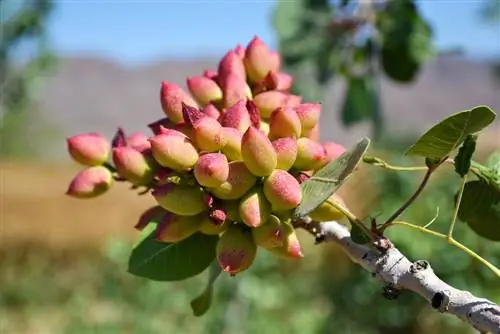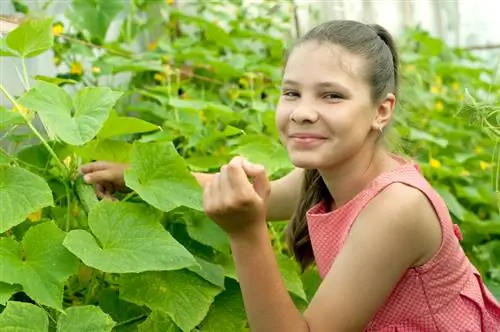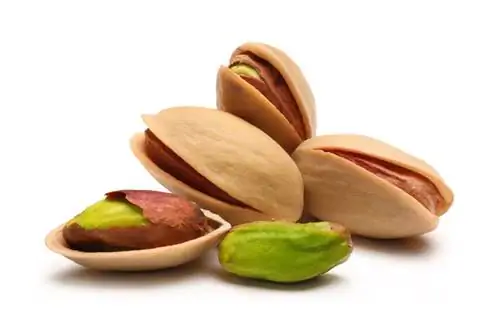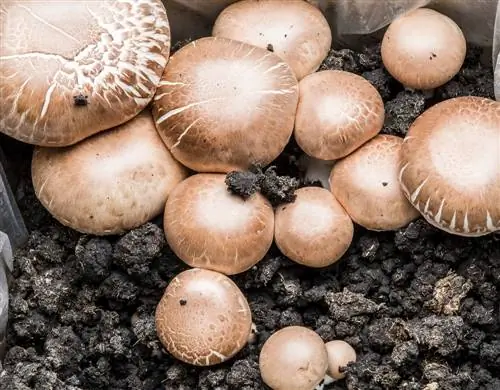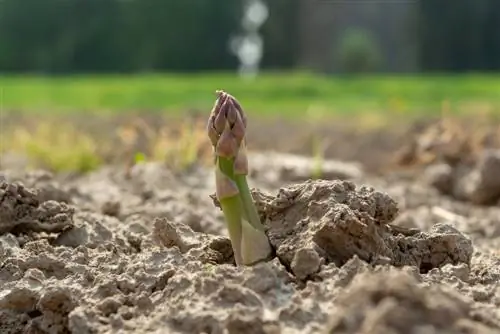- Author admin [email protected].
- Public 2023-12-16 16:46.
- Last modified 2025-01-23 11:22.
Read here in the commented profile information about the origin of the pistachio tree. You can find out how to properly plant and care for a pistachio in Germany here.
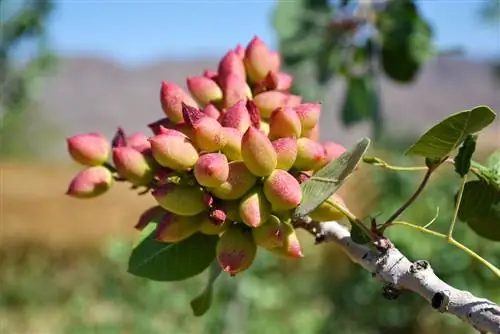
How do I plant and care for a pistachio tree in Germany?
Pistachio trees (Pistacia vera) are originally from the Middle East and the Mediterranean. In Germany they can be planted in pots or in regions with mild winters. Pay attention to locations in full sun, well-drained soil and regular watering without waterlogging. Harvest the stone fruits after about 4 months of ripening.
Profile
- Scientific name: Pistacia vera
- Family: Sumac family (Anacardiaceae)
- Synonyms: Real pistachio, pistachio
- Origin: Middle East, Mediterranean
- Growth type: tree or shrub
- Growth height: 3 m to 5 m
- Leaf: pinnate
- Flower: panicle
- Fruit: Drupe
- Fruit properties: edible
- Winter hardiness: conditionally hardy
- Use: Mediterranean garden, potted plant
Origin
Where do pistachios grow? The pistachio tree is one of the oldest flowering cultivated plants. The pistachio originally comes from the Middle East. From there, the sumac family with its nutritious fruits spread across the Mediterranean region. The triumphal march across the Atlantic began in the 1880s when immigrants imported the first pistachios to America. Today the world's second largest growing region is in California. The main growing region is undisputedly Iran.
Well-known European producers are Greece, Italy and Spain. Pistachio cultivation in Germany primarily takes place in hobby gardens.
Video: Growing pistachios in the hobby garden
Bloom
The pistachio plant is dioecious with separate sexes. Male and female flowers thrive on different trees. If you want to harvest home-grown pistachios, you need to plant at least two trees. Furthermore, insects ignore a flowering pistachio tree, which complicates the transfer of male pollen to female flowers. The following characteristics characterize the flower:
- Inflorescence: paniculate, many-flowered
- Single flower: fivefold, greenish-brown, yellowish, reddish inconspicuous
- Flowering time: April
- Pollination: Wind
The time window for wind pollination in Germany is 4 to 5 days. Experienced hobby gardeners therefore help with manual pollination and transfer the pollen with a soft brush.
Fruit
Following pollination, female flowers turn into crunchy pistachios. Contrary to popular belief, these are stone fruits and not nuts. The following table lists important fruit properties:
| Fruit properties | Information per fruit | Nutrients | 100 g each of fresh, peeled pistachios | Nutritional values | 100 g each of fresh, peeled pistachios |
|---|---|---|---|---|---|
| Size | 2 m | Potassium | 1010 mg | Calorie | 518 kcal |
| Fruit cover | green, yellowish-reddish-pink | Phosphorus | 500 mg | Fat | 52g |
| Stone core size | 1, 2 to 1, 4 cm | Magnesium | 160 mg | Protein | 18g |
| Stone core shell | not edible | Calcium | 135 mg | Carbohydrates | 12g |
| color | beige to brownish | Iron | 7, 5 mg | Fiber | 10g |
| Pistachio nuts | edible | Sodium | 5 mg | ||
| color | light green to green | Vitamin C | 7 mg |
The harvest yield is characterized by extreme fluctuations. As a rule, every mast year is followed by a year of low yield, as we know from local acorns, beechnuts and chestnuts.
Planting a pistachio tree
For growing pistachios in the hobby garden, it is advisable to buy a refined pistachio tree from a specialist retailer. Purchasing sources in Germany are few and far between. In spring there is a good chance that you will find what you are looking for at flora-tosakana.de or zitronenlust.de. You can find out when, where and how to plant a pistachio tree correctly in the following sections.
Planting time
The best time to plant pistachios is mid-May to early June. After the Ice Saints, the danger of nighttime ground frosts has passed. For pistachio plants that have already been purchased, use the waiting time until planting to harden off. Place the trees in a bright, warm place during the day and put the plants away again in the evening.
Location
In summer, the pistachio prefers dry, hot desert climates for productive, he althy growth. All important location conditions at a glance:
- Full sunny, warm to scorching hot.
- Potted plants preferably in a place protected from rain and wind on a balcony or terrace.
- In the winter garden or living room, ideally on the south side of the house.
- Planted in regions of hardiness zones Z7 and Z8.
- Soil texture: permeable, sandy-dry, calcareous, pH value 7 and higher.
Plant in a pot
In Germany, pistachios are mainly grown in containers. As a mobile potted plant, it is easy to change locations during late frosts or when moving to winter quarters. The optimal substrate is a mixture of container plant soil and inorganic, coarse-grained aggregates for loose permeability. Expanded clay, lava granules, sand or fine-grained grit are well suited. Use some of the aggregate as drainage on the bottom of the pot.
Plant in the bed
In a location with a Mediterranean microclimate, a pistachio tree can grow very large and very old. In the botanical garden of the University of Bonn you can admire a Pistacia Methuselah in the open air as living proof. When planting, please ensure a generous planting distance of at least three meters. Pistachio roots are very sensitive and tolerate transplanting poorly. Drainage in the planting hole made of grit or coarse sand is recommended.
Excursus
Pistacia dream couple Peter and Kerman
If you buy a pistachio tree, it should always be in a double pack. The unbeatable dream team for private pistachio cultivation in Germany is the pistacia man Peter and his better half, the pistachio lady Kerman. After pollination, after 16 weeks of ripening, you will harvest crunchy pistachios of the highest quality with a sweet, delicate taste.
Harvesting
Pistachios are harvested after a ripening period of around 4 months. The yellowish-reddish outer shells burst open and reveal the ripe pistachio kernels, which are covered in a pinkish-brownish skin. For a premium quality harvest, it is important that the pistachios do not come into contact with soil. Spread a sheet of foil or blanket under the pistachio tree and shake the trunk. Enjoy the delicious fruits fresh from the tree, roasted or s alted.
Care for the pistachio tree
The pistachio tree is very easy to care for. Modest requirements, slow growth and limited winter hardiness characterize the simple care program. You can read the best tips for keeping two pistachio plants in top shape here:
Pouring
The water requirement is low. The greatest danger to a pistachio tree in Germany is waterlogging and not drought stress. How to water pistachio plants properly:
- Water potted plants when the substrate has dried significantly.
- Let normal tap water run onto the ground until the first drops run into the saucer.
- If in doubt, spray the leaves with lime-free water and only water them the next day.
- Pour out the water-filled coaster promptly so that no waterlogging forms.
Freshly planted pistachios in the bed depend on regular watering in dry conditions in the first year. You don't need to water an older, planted pistachio tree at all. In sandy, permeable soil, the roots grow up to 15 meters long and easily reach the groundwater.
Fertilize
Fertilize pistachio plants in the pot from April to September with an organic complete fertilizer (€19.00 on Amazon) for fruit and vegetables. Add the liquid fertilizer to the irrigation water every 14 days. Fertilize bedding pistachios with compost and horn shavings in March and June.
Wintering
For flower induction on the pistachio tree, 1000 hours at an average of 7° Celsius are required to break bud dormancy. This is the main premise for the perfect winter quarters. How to properly overwinter a pistachio plant:
- Put away the container in October, at the latest before the first frost.
- Pistachio tree overwinter in light or low-light conditions at 5° to 8° Celsius (+/- 5° Celsius)
- Wate very sparingly.
- Do not fertilize from October to March.
- Potential winter quarters: unheated winter garden, garage, stairwell, winter tent with frost monitor.
You can overwinter a pistachio tree outdoors like a pomegranate tree or an olive. Cover the crown with a breathable, translucent winter fleece. Mulch the tree disc to a height of 15 cm to 20 cm with leaves, bark mulch, straw and needle twigs. To protect against frost cracks, wrap the trunk with jute ribbons.
Repotting
If the roots grow out from under the bottom of the container, you should repot the pistachio tree. The best time is in spring when the plant leaves its winter quarters. Rinse the old substrate under running water to avoid damaging the delicate roots. Because pistachios grow so slowly, this care measure is rarely on the agenda.
Propagate
The otherwise easy-care pistachio tree becomes unruly when propagated. Cuttings root annoyingly slowly. Sowing pistachio seeds is somewhat promising for hobby gardeners. The following key data must be observed:
- Time window: all year round, ideally after the harvest (only fresh pistachio kernels germinate reliably).
- Pretreatment: Soak seeds in lukewarm water or chamomile tea for 2 to 3 days.
- Sowing depth: Only half cover light germinators with substrate.
- Sowing soil: Coconut soil or cactus soil with lava granules and sand.
- Germ temperature: 18° to 22° Celsius in a bright window seat.
- Germination time: 4 to 6 weeks.
For hobby gardeners with many years of experience, propagation from cuttings is worth a try. In early summer, cut half-woody cuttings, remove two-thirds of their leaves and plant them in well-drained coconut soil.
Popular varieties
In addition to the premium varieties Pistacia vera 'Peter' and Pistacia versa 'Kerman', there are other offers on the market for hobby gardeners who want to grow pistachios themselves:
- Mastic bush (Pistacia lentiscus): evergreen shrub for the container or planted out in regions with mild winters.
- Chinese pistachio tree (Pistacia chinensis): Ornamental variety with bright yellow autumn color and red, peppercorn-sized fruits that are not edible.
- Mount Atlas Pistachio (Pistacia atlantica): deciduous or semi-evergreen pistachio tree, growth height up to 7 m.
- Turpentine pistachio (Pistacia terebinthus): richly branched tree or shrub, light yellow flower spikes up to 20 cm long, beautiful pinnate leaves with an aromatic scent.
FAQ
Is the pistachio tree hardy?
A pistachio tree is conditionally hardy because it can tolerate temperatures below freezing for short periods of up to -10° Celsius. For cultivation outdoors, the pistachio is primarily suitable for locations in winter hardiness zones 7 and 8, such as the mild winter Rhineland. Planting in containers is recommended in all other regions of Germany.
Where can you buy a pistachio tree in Germany?
Purchasing sources for Pistacia vera are few and far between in Germany. We looked around for you and found two competent suppliers for pre-grown pistachio plants: flora-toskana.com and zitronenlust.de enjoy good customer reviews. The latter is also represented on Amazon. sunshine-seeds.de has earned a good reputation for purchasing high-quality Pistacia seeds.
How do pistachios grow?
Pistachios grow as dioecious, separate-sex trees or shrubs with limited winter hardiness. Female flowers turn into edible drupes within four months after wind pollination. Pistachio plants are naturally evergreen. In the Central European climate, the trees shed their leaves. Planted Pistacia reach a height of up to 12 meters. Potted plants grow 3 meters to 5 meters tall.

